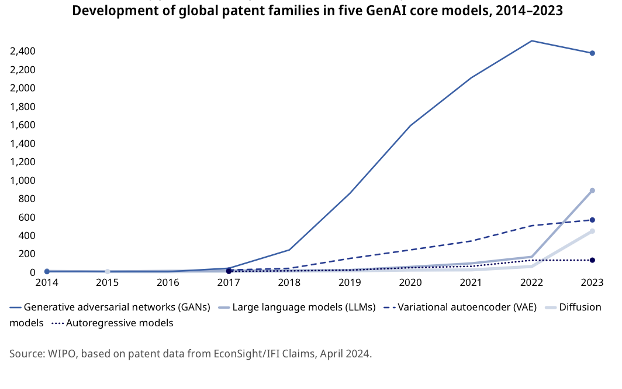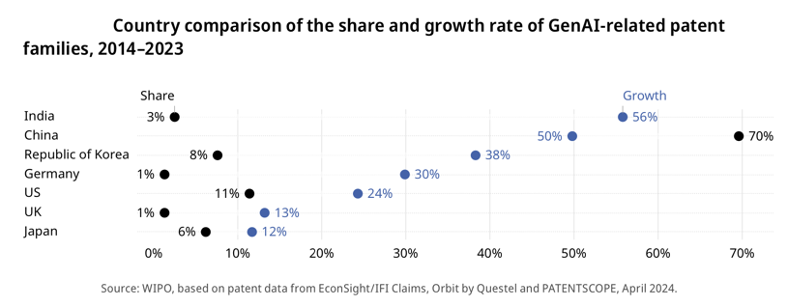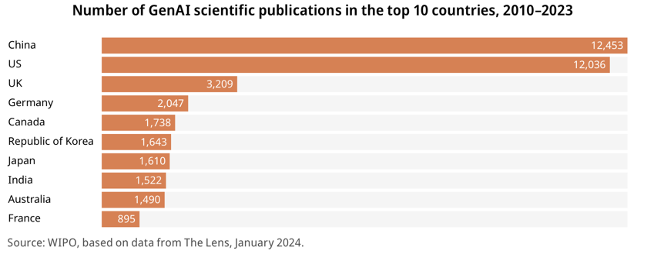Generative AI models and patenting trends in India
Generative AI (genAI) technology has become increasingly vital in the present era due to its ability to enhance efficiency, innovation, and problem-solving. It can automate repetitive tasks, generate creative ideas, and analyse complex data, leading to significant advancements in various industries. From accelerating drug discovery to improving customer service, generative AI is reshaping the way we work and live, making it a crucial tool for addressing the challenges and opportunities of the modern world. Recently, the World Intellectual Property Organisation (WIPO) published its Patent Landscape Report on Generative Artificial Intelligence detailing the patenting trends in various application fields such as image/video generation, 3D imaging models, molecular/protein, etc. The report also highlighted the top countries, and companies involved in patenting generative AI models. The present blog is aimed to provide a short overview of patenting trends globally and in specific with regard to generative AI development in India.
What is Generative AI?
Generative AI is a branch of artificial intelligence that focuses on creating new content, rather than just analysing or processing existing data. It's like a smart assistant that can write stories, compose music, generate images or even create videos from scratch. It works by using complex algorithms and models that learn from large databases, recognise patterns and relationships, and generate unique and original content based on the learned information.
There are several key models in generative AI, each with a unique approach.
·Generative Adversarial Networks (GANs) work like a game between two models: a generator and a discriminator. The generator creates new content (such as images), while the discriminator evaluates whether the content is real or generated. As they compete, both improve, which leads to highly realistic results.
·Variational Autoencoders (VAEs) are models that compress input data into a simpler form and then reconstruct it. During this process, the model learns the key characteristics of the data and can generate new samples that are similar to the originals, but with slight variations.
·Large Lenguafe Models (LLMs) such as GPT are particularly effective at generating text, because they analyse the context of words to produce coherent and relevant text, enabling tasks such as essay writing and conversation.
As you may know, AI has countless applications across a wide range of industries, and its potential is limited only by our imagination. More and more businesses are using it to create personalised marketing content, tailoring emails and social media posts to capture the attention of specific audiences. In the world of art, it is helping artists and musicians create new works. In the healthcare sector, it is speeding up the research process in drug development through the simulation of molecular interactions.
Global Patenting Trends in Generative AI
In recent years, there has been a significant increase in the global patent landscape for generative AI as a result of the rapid development and commercial interest in this technology. Both leading companies and start-ups are increasing their patent applications to protect innovations in areas such as natural language processing, image generation and automated content creation. This rise in patent activity is particularly notable in North America, Europe and Asia, where there is intense competition in the field of generative AI. Furthermore, collaboration between academia and industry has resulted in a wide range of patents covering both fundamental algorithms and applications in sectors such as healthcare, entertainment and finance.
The global patenting trend in generative AI is led by China, which published more than 70% of all global GenAI patents between 2014 and 2023, which amounts to approximately 38,210 patent families. In second place is the United States, with 6,276 patent families, mainly focused on variational auto-encoders (VAEs) and large language models (LLMs). The Republic of Korea and Japan are also notable players with 4,155 and 3,409 patent families respectively, particularly in areas such as generative adversarial networks (GANs). India has seen a significant increase in patent activity, with 1,350 patent families, while Europe is led by Germany with 708 patents and the UK with 714, both focused on GANs and VAE.

Regarding the types of AI models patented, GANs are the most common with 9,700 patent families, mainly used for image generation and video synthesis. VAEs follow with around 1,800 patent families, popular for data generation and anomaly detection. In addition, LLMs, with 1,300 patent families, have become very popular due to applications such as ChatGPT. A newer technology, diffusion models, also showed a significant development, increasing from 18 patents in 2020 to 441 in 2023. These models are mainly used to create high-quality images from text descriptions and for image manipulation. Lastly, autoregressive models are also part of the GenAI landscape, although they had the weakest growth, they are often used in time series forecasting and sequential data generation.

Patenting Trends in the European Union
Since 2017, the European Union (EU) has shown a noteworthy increase in patent applications related to generative AI, driven not only by rapid technological development, but also by a favourable environment for innovation. Countries such as Germany, France and the Netherlands lead the way in terms of patent activity, at the same time smaller countries such as Estonia and Finland also play a significant role in the European landscape, thanks to their start-up ecosystems. Indeed, the EU regulatory framework, through the European Patent Office (EPO) and programs such as Horizon Europe, provides strong support for the protection of generative AI innovations. However, despite these positive trends, challenges remain, including the complexity of AI technologies and the need to adapt patent laws to address emerging issues related to ownership and liability of AI-generated content.
The leading European companies in this regard are: the German company Siemens, which has an expertise in industrial automation and process optimisation; and SAP, also based in Germany, which has focused on integrating GenAI into its business solutions, improving data analytics and business process automation. In addition, DeepMind (part of Alphabet), although based in the UK, has made significant contributions to the development of LLMs and GANs.
On the other hand, European universities and research institutions not only contribute to academic knowledge, but also have a direct impact on the development of the GenAI industry. For instance, the Technical University of Munich (TUM) is well-known for its applied AI research and the development of patents in GANs and VAE. The University of Cambridge, through its Cambridge Centre for AI in Medicine, has filed patents in text generation and predictive models, applying AI to healthcare. Other institutions such as ETH Zurich and the University of Oxford are also at the forefront, patenting technologies in robotics, data science and natural language processing.
Patenting Trends in India
As it was mentioned, India has also experienced significant growth in generative AI-related patent activity, particularly in areas such as networks and smart cities. Between 2014 and 2023, the country achieved an annual growth rate of 56%, making it one of the top six leaders in the field, just behind Japan. In addition, the Indian government continues to support innovation through initiatives such as 'Make in India', which encourages local companies to invest in R&D and protect patents, but we should not forget the challenges that remain, such as the need to improve understanding of the patenting process and manage the regulatory environment.

Companies that are contributing to India's development such as Krutirim AI, specialise in innovative natural language processing and machine learning solutions. Others, such as Xylem AI, focus on LLMOps (Large Language Model Operations) platforms for efficient training and deployment of personalised language models. Another company of note is Aikenist, which focuses on AI-powered patient engagement platforms for healthcare management.
In terms of academia, since 2014, the number of scientific publications related to GenAI globally has dramatically increased from around 100 in 2014 to over 34,000 by 2023, of which 1522 publications are from India. Although India has not yet reached the publication levels of countries such as China and the US, with 12,453 and 12,036 publications respectively, its contribution is significant and shows continuous growth. In addition, India's scientific output has received 10 195 citations, which highlights its impact in the international community.

Conclusion
The patenting trends highlight India is poised to become one of the global leaders in generative AI development, driven by its large pool of skilled talent and growing technological advancements. The country's burgeoning tech ecosystem, coupled with government initiatives to promote AI adoption, presents significant opportunities for innovation and economic growth. The Government of India, celebrating Artificial Intelligence Appreciation Day on July16th of 2024, has dedicated $1.13 billion for the India AI Mission. Additionally, a series of collaborations with global AI enterprises, vocational training, youth boot camps, and AI competency development centres are being created to upskill and promote AI adoption. The proactive push from the government, the varied and large market opportunities and the availability of the talent pool do provide fertile grounds for European SMEs to explore, collaborate and ride the AI wave with Indian partners.
-
Previous:
-
Next:






